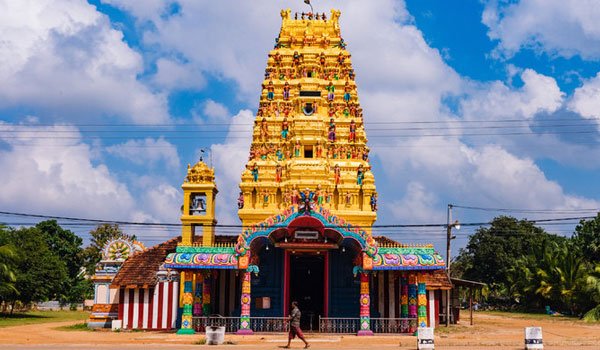It was here, in January 2009, that two divisions of Sri Lankan troops pushed down from the peninsula, converging with two other divisions marching from the south, to begin a final offensive against the Liberation Tigers of Tamil Eelam, otherwise known as the Tamil Tigers. “The gallant operation [was] launched under the state leadership of the president ... who was born for the grace of the nation,” declared a plaque at the base of the statue, commemorating Sri Lanka’s hard-line leader at the time, Mahinda Rajapaksa. In overblown language, the inscription noted that the troops had “traversed scrubs, impassable moats, quagmires and ... dreadful traps ... liberating this long path and annihilating terrorism.”

Until just a few years ago, this corner of Sri Lanka was off-limits to outsiders. A civil war had raged across the Jaffna Peninsula and the Vanni for almost 30 years, pitting Tamil separatists against the country’s Sinhalese majority government. The Tigers carried out devastating suicide bombings in southern Sinhalese strongholds, including Colombo; assassinated political leaders; and massacred Sinhalese civilians. In the final five months of the conflict, government forces waged a merciless campaign to destroy the Tigers and their supporters, shelling hospitals and “No Fire Zones” packed with civilians and killing tens of thousands of people. In 2014, the government barred United Nations investigators from entering the country to look into allegations of war crimes.
But in 2011, with the region pacified, President Rajapaksa began relaxing his stringent security measures, allowing in both Sri Lankans from the south and foreigners.
Today, tourists can explore islands, beaches and villages that haven’t been exposed to visitors in decades; steep themselves in the Tamils’ culture and history; and visit war museums, the former hide-outs of some of the guerrillas’ most notorious commanders; and former battlefields. Sri Lanka’s government has even turned a few of these places into vacation resorts, sometimes inflaming Tamil sensitivities. “Enjoy a soothing holiday and the cool breeze of Nanthi Kadal lagoon,” declares the Facebook page of Lagoon’s Edge, a military-owned villa overlooking an estuary in the Vanni where thousands of fighters and civilians died in the army’s 2009 onslaught.
Last year’s election, which brought Maithripala Sirisena, a moderate Sinhalese, to power, raised hopes for reconciliation, and an end to government obfuscations about the brutality that took place here during the war’s final months.
To reach the north, I traveled from the ancient Sinhalese Buddhist capital of Anuradhapura to Jaffna on the Northern Line, the old British-built railroad that runs for 211 miles through Sri Lanka’s interior. In the 1980s, Tiger bombings and sabotage forced the line to shut down; the guerrillas then seized control of the adjacent territory, ripped up the rails to make bunkers, and let the jungle reclaim what was left. Bombing raids by the Sri Lankan Air Force reduced stations to rubble.
Financed by loans from Indian Railways and other sources, President Rajapaksa’s government rebuilt the line over five years. On a sunny afternoon in October 2014, the president made the inaugural journey to Jaffna aboard the Queen of Jaffna train, known in Tamil as the Yari Devi. Garlanded with flowers and banana leaves, it rolled into Jaffna to an explosion of cheers and firecrackers.
My own journey on the Northern Line took place with less fanfare. The train arrived at Anuradhapura’s sleepy station two hours behind schedule, and I took a seat in the nearly empty first-class car. Walking through the train as it rumbled through paddies and jungle, I encountered a microcosm of Sri Lanka’s population. Two young men sitting together in a second-class compartment told me they were military officers returning to their base in Kilinochchi, the former Tigers capital in the Vanni, but politely rebuffed my attempts at further conversation.
In a crowded third-class car I met a Tamil Hindu family — husband, wife and teenage son — traveling to Jaffna from their home in Colombo to visit the man’s ailing mother. It was the first time that the 62-year-old railway worker had ridden the line since the 1980s, and he gave President Rajapaksa grudging credit. “He built roads, the railways are running, education is better,” he told me in Tamil, which his son translated. But the Tamil people, he added, shifting nervously in his seat, “have to watch what we say. We do not feel protected.”
After five hours we pulled into Jaffna, dominated by a heavily shelled Portuguese-built fort, where the Tigers once held sway. The army drove the guerrillas out of the Jaffna Peninsula 20 years ago, forcing them to take refuge in the Vanni to the south, and, for many Jaffna residents, the war has faded into a distant memory.

Worshipers gather every Friday at the city’s elaborate Hindu temples to make puka, or devotions, to their gods. The military curfew has been lifted, and outdoor restaurants are packed at night with Tamil families dining on dosas, idlis and other specialties of the distinctive cuisine that Jaffna shares with Tamil Nadu, India’s southernmost state.
Scholars and students fill the Jaffna library, an opulent, Indo-Saracenic-style edifice. After a pro-separatist Tamil party held a rally in Jaffna in 1981 in which two Sinhalese policemen were killed, a mob burned the library to the ground, an act that served to catalyze the conflict. But the library was restored two decades ago, and it has again become a center of Tamil intellectual life.
The next morning my guide, a Tamil architect named Kumaralingan Pathyran but known to everyone as Pathy, and I followed a causeway across a lagoon to the western edge of the peninsula. There we boarded a navy-operated ferry and motored toward Delft, one of several remote islands in the Palk Strait dividing Sri Lanka and India. I secured a perch on the tiny foredeck. Below, dozens of locals huddled in a dark and cramped cabin.
As we crossed the strait, Pathy told me that the body of water was the site of what was called a massacre. In May 1985, six men believed to be from the Sri Lankan navy boarded the Kumudini, a ferry sailing from Delft, and hacked to death 23 Tamil men, women and children. The slaughter was in revenge for a mass killing carried out by the Tigers around Anuradhapura days earlier.
Alighting in Delft’s soporific port, we hired a motorized rickshaw and bounced down decrepit roads, past Hindu temples, stopping to view various curiosities left by Sri Lanka’s succession of European conquerors: a giant baobab brought by the Portuguese in the 16th century from Madagascar; a ruined 17th-century Portuguese fortress built of coral; a herd of wild horses galloping across a barren plain, the descendants of those brought over, then abandoned, by Dutch colonizers 300 years ago; a stone aviary used by a British governor to house his carrier pigeons.
There were no hotels, no restaurants, no tourist infrastructure, just a back-of-beyond landscape and miles of empty beach. Pathy and I bought fish at a market by the port and hired a local man to prepare a curry with chiles and coconut milk. On a deserted strip of sand battered by rough waves, we ate out of a communal pot, as feral cats gathered.
Just past the Elephant Pass, at the edge of the Vanni, a grandiose memorial celebrates the life of Gamini Kularatne, an ordinary Sinhalese soldier who, in July 1991, single-handedly disabled a Tiger bulldozer packed with explosives, and died. It typifies the iconography indulged in by the Rajapaksa government to glory in its victory and to remind the Tamils of the cost of resistance.
The shredded remnants of the Caterpillar, which Gamini Kularatne attacked with grenades, are mounted on a pedestal, surrounded by a carp pond, a fountain and exhibits chronicling every twist and turn in the young hero’s life: a New Year’s greeting from the soldier to his mother, a 1988 pay slip, snapshots of his wedding. Farther down the road an outdoor museum displays captured Tiger speedboats, submarines, even a mini-destroyer. In Kilinochchi, which the Tigers occupied for a decade, I inspected a 60-foot-high water tank lying on its side, a tangle of concrete and rebar that was toppled by the Tigers in the spring of 2009 as they retreated.
Pathy and I drove down a dirt road through the jungle, followed by clouds of green parakeets. After a 15-minute drive, we stopped before a brick bungalow with a red-tile roof and an orange stucco facade. Soldiers sat on the veranda and milled about the garden. This was the former hideaway of Velupillai Prabhakaran, the charismatic founder of the Tamil Tigers.

A high-school dropout from Jaffna, Mr. Prabhakaran tried to build an egalitarian utopia in the Tiger-occupied Vanni, but he grew increasingly isolated, paranoid and brutal; Sri Lankan troops captured and executed him in the last days of the government’s offensive. His house, laced with underground bunkers, is open to the public, but this day the soldiers refused to let us enter, claiming that the bunkers were in danger of collapse. Instead we had to settle for a visit to the nearby home of Colonel Soosai, the commander of the Sea Tigers, the rebels’ naval force, who was killed a few days before Mr. Prabhakaran.
“Enemies are our best teachers” read a sign placed by government soldiers over the doorway to the guerrilla chief’s bungalow. I walked down a narrow flight of steps concealed inside a closet, and found myself in a long, mud-filled tunnel — a secret escape route that burrowed beneath Colonel Soosai’s garden.
The Tigers made their final stand at the Nanthi Kadal Lagoon, a few miles down the coast. The road followed an unbroken swath of jungle, bordered by yellow tape and signs displaying a skull-and-crossbones and the warning, “Mines,” in English, Sinhalese and Tamil. Soldiers were still sweeping the jungle for buried explosives and had blocked off many dirt roads leading to the lagoon. Eventually we found our way to the Vaddu Vakal Bridge, not far from Lagoon’s Edge, the military-owned villa now being marketed as a getaway for tourists.
A scene of pristine beauty surrounded me. Looking north toward the Indian Ocean, I could see distant breakers crashing against a golden beach. On the inland side of the bridge, herons flew over tidal flats and islets covered with marsh grass, and palmyras swayed over the thick brush that grew along the shore. But the serenity belied the horror that had unfolded here. In May 2009, the Sri Lankan army trapped 100,000 civilians and Tiger guerrillas between the jungle and the ocean, and shelled them relentlessly.
Today a military guard post flanks one end of the span, along with a sign that reflects the Sinhalese victors’ view of history. It proclaims that this was the site of “heroic victory” over “ruthless terrorists,” by government troops who saved the civilians in a “humanitarian operation.”
I fell into a conversation with a grizzled Tamil fisherman who was dangling a line off the bridge. He’d been trapped here with thousands of others in 2009, he told me, but “there has no been no problem here since the ‘liberation.’ ” He cast a nervous glance toward the military guard post, and then hurried away.
Seven years after a brutal war, peace and tourism have returned to Sri Lanka’s north, but normality remains more elusive.
Explorer
By JOSHUA HAMMER
(nytimes.com)






